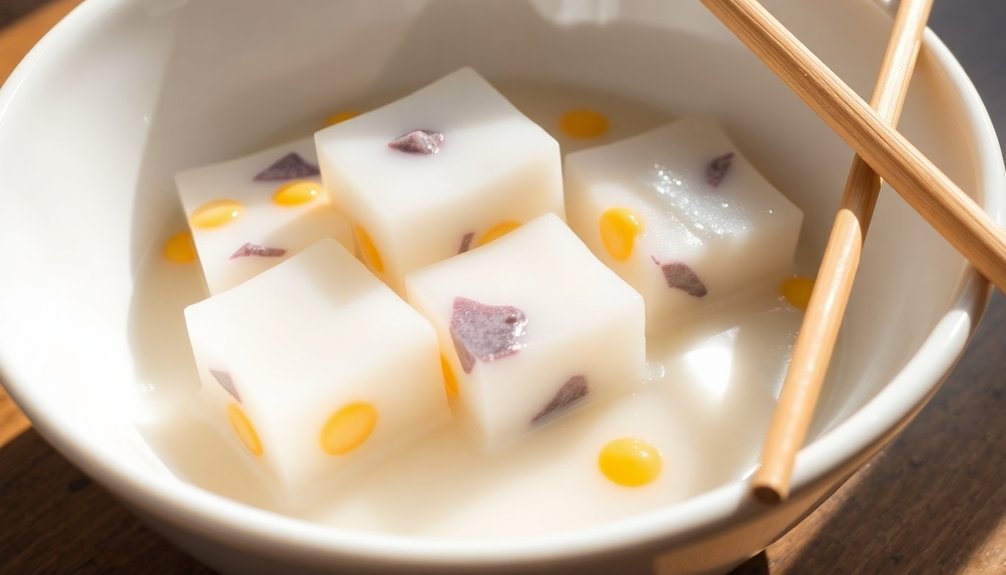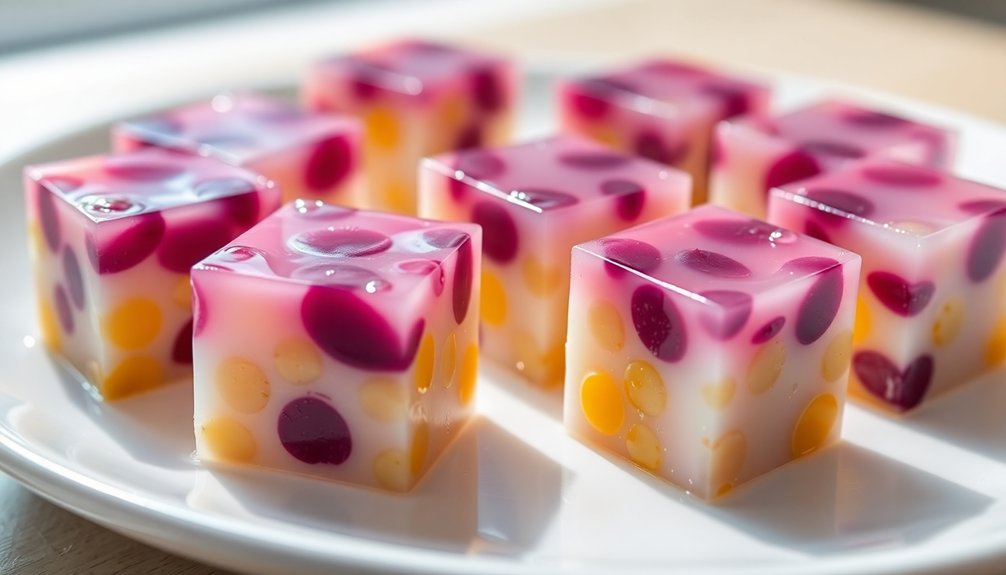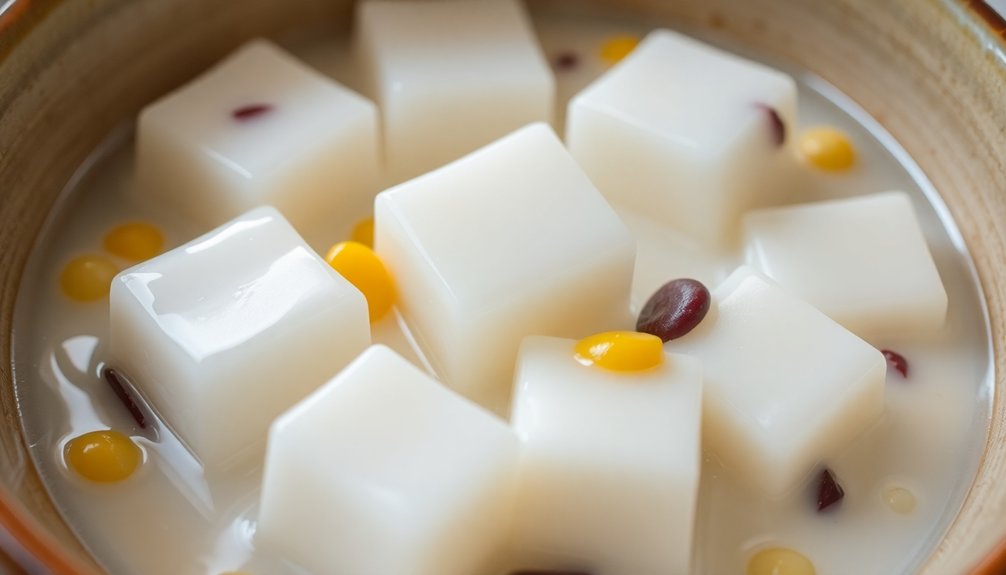Tako - Coconut Pudding With Corn or Taro
Tako is a creamy Southeast Asian dessert made with coconut milk and either sweet corn or taro. You'll find this pudding at celebrations across Thailand, Malaysia, and Indonesia, where each region offers unique variations. The dessert combines rich coconut with the natural sweetness of corn or the earthiness of taro, creating a revitalizing treat. Its simple preparation belies the complex flavors that have made it a beloved tradition passed down through generations.
Key Takeaways
- Tako is a popular Southeast Asian dessert made with coconut milk and either sweet corn or taro.
- The dessert features a creamy pudding texture and is especially common in Thailand, Malaysia, and Indonesia.
- Traditional preparation includes simmering coconut milk with sugar before adding cornstarch and corn or taro.
- Regional variations include Thai versions with pandan layers and Malaysian versions highlighting sweet corn.
- Tako should refrigerate for at least 2 hours until set and can be customized with different sweeteners like palm sugar.
History

While the exact origins remain unclear, coconut pudding with corn or taro emerged as a beloved dessert across Southeast Asia, particularly in Thailand, Malaysia, and Indonesia.
You'll find this treat's cultural significance deeply rooted in traditional celebrations and family gatherings, where it's often served during festivals and special occasions.
As you explore its history, you'll discover fascinating regional variations that have evolved over generations.
In Thailand, you'll encounter it as "tako," featuring pandan-flavored layers, while Malaysian versions often incorporate sweet corn.
Indonesian interpretations might include black sticky rice or fresh fruit.
The dish's evolution reflects the ingenuity of local cooks who've adapted it using indigenous ingredients, creating distinct versions that showcase each region's culinary heritage.
Recipe

Ingredients:
- 4 cups coconut milk
- 1 cup sweet corn kernels or diced taro
- 1/2 cup sugar
- 3 tablespoons cornstarch
- 1/4 teaspoon salt
- 1 teaspoon vanilla extract (optional)
Instructions:
- Mix cornstarch with 1/2 cup coconut milk until smooth.
- In a saucepan, combine remaining coconut milk, sugar, and salt.
- Bring mixture to a simmer over medium heat, stirring occasionally.
- Add corn kernels or taro pieces and cook for 5 minutes.
- Slowly whisk in cornstarch mixture while stirring constantly.
- Continue cooking and stirring until pudding thickens, about 3-5 minutes.
- Add vanilla extract if using.
- Pour into serving bowls or a large container.
- Let cool to room temperature.
- Refrigerate for at least 2 hours until set.
Serves 6-8
Cooking Steps

You'll want to start by bringing the coconut milk to a gentle simmer, stirring occasionally until it thickens and releases its sweet aroma.
Next, whisk together your sugar and cornstarch mixture into the warm coconut milk until smooth, then pour the velvety blend into your pre-chilled molds.
After the pudding has cooled and set firmly, gently unmold each portion onto serving plates for an elegant presentation.
Step 1. Boil Coconut Milk Until Thickened
Bringing coconut milk to a steady simmer marks the critical first step in creating this luscious pudding. You'll need to stir constantly as the coconut milk heats up, watching for tiny bubbles to form around the edges of your pot.
The thickening process requires patience and attention - keep the temperature moderate to prevent scorching or separation of the coconut milk.
As you continue stirring, you'll notice the mixture gradually becoming more viscous. The natural fats in the coconut milk will help create that silky texture you're looking for.
When the mixture coats the back of your spoon and you can draw a clear line through it with your finger, you've reached the right consistency. This stage typically takes about 10-15 minutes of gentle simmering.
Step 2. Combine Sugar and Cornstarch
The perfect balance of sweetness and structure begins with thoroughly combining your granulated sugar and cornstarch in a separate bowl before introducing them to the simmering coconut milk.
Whisk these dry ingredients vigorously, breaking up any lumps to guarantee your pudding sets smoothly without grainy pockets. You'll need approximately 1/2 cup sugar per can of coconut milk, though you can adjust according to taste.
While standard white sugar works beautifully, consider palm sugar or coconut sugar for authentic depth of flavor.
If you're seeking cornstarch alternatives, arrowroot powder creates a similar silky texture with a slightly more translucent finish, while tapioca starch yields a bouncier consistency.
Regardless of which thickener you choose, the vital technique remains the same—prevent clumping by creating a uniform dry mixture before it meets liquid heat.
Step 3. Pour Into Chilled Molds
Once your pudding has reached the perfect consistency—thick enough to coat the back of a wooden spoon while still pourable—it's time for the essential transfer to pre-chilled molds.
Choose your mold selection wisely, considering both presentation and practicality. Small ramekins create elegant individual servings, while a large glass bowl makes for a dramatic centerpiece.
Whatever you choose, guarantee they've been thoroughly chilled in the refrigerator for at least 30 minutes.
For clean pouring techniques, use a ladle to carefully transfer the pudding into each mold, or pour directly from the pot using a steady hand and controlled stream. Fill each mold about 80% full, allowing room for toppings later.
If bubbles appear, gently tap the molds against the counter. Cover each filled mold with plastic wrap pressed directly onto the surface to prevent skin formation.
Step 4. Cool Until Set Firm
After carefully pouring your coconut pudding into chilled molds, patience becomes your most valuable ingredient. Allow the pudding to cool at room temperature for 15-20 minutes before transferring it to the refrigerator. This gradual chilling technique prevents condensation from forming on the surface, ensuring a perfectly smooth texture.
For ideal setting, refrigerate your pudding for at least 4 hours, though overnight chilling yields the firmest results. You'll know it's properly set when the surface feels firm to a gentle touch and the mold's sides pull away slightly.
If you're in a hurry, one of the best setting tips is to use smaller, individual molds rather than a single large one. The increased surface area helps the pudding cool and set more quickly while maintaining that luscious coconut-corn or taro flavor.
Step 5. Unmold and Serve Portions
When your coconut pudding has fully set, it's time for the grand reveal that transforms your culinary creation from humble mold to elegant dessert.
Run a thin knife along the edges to loosen the pudding, then place your serving platter upside-down over the mold. With one swift, confident movement, flip everything over and gently lift the mold away. Your tako should release cleanly, showcasing its distinctive layers.
For ideal portion sizes and serving suggestions:
- Cut clean triangular wedges (about 1/8 of the pudding) for traditional serving size that balances richness with satisfaction.
- Garnish with fresh fruit slices, toasted coconut flakes, or a light dusting of cinnamon for visual appeal.
- Serve slightly chilled rather than cold to enhance the coconut aroma and creamy texture.
Cooking Tips

Mastering coconut pudding requires attention to a few essential details that transform a decent dessert into an exceptional one.
When heating coconut milk, stir constantly to prevent scorching and maintain its silky texture. You'll notice it's ready when tiny bubbles form around the edges rather than a rolling boil.
For ingredient substitutions, brown sugar offers a deeper caramel flavor than white, while palm sugar provides authentic tropical notes.
Don't have fresh corn? Frozen works perfectly when thawed and patted dry. Traditional taro can be replaced with purple sweet potato for a similar starchy sweetness and visual appeal.
The key cooking technique lies in managing temperature—gentle heat preserves coconut's delicate flavor.
You'll achieve the perfect consistency by removing the mixture from heat once it coats the back of a spoon.
Final Thoughts

Coconut pudding with corn or taro represents more than just a sweet ending to your meal—it embodies cultural heritage in every spoonful.
The cultural significance of tako extends beyond its delicious taste, connecting generations through shared culinary traditions that have evolved across Pacific and Southeast Asian communities.
To fully appreciate this beloved dessert:
- Experiment with flavor variations by trying both corn and taro versions to discover your preference.
- Serve at family gatherings to create meaningful food memories and honor traditional recipes.
- Consider the seasonal availability of ingredients when planning to make this pudding at its freshest.
You'll find that mastering this simple yet profound dessert offers a window into culinary history while satisfying your sweet cravings with tropical richness.
Frequently Asked Questions
Can Tako Be Made Without Coconut Milk?
Yes, you can make tako without coconut milk by substituting other alternative milk options like almond or soy milk. You'll experience different flavor variations while maintaining the dessert's creamy, delightful texture.
Is Tako Gluten-Free?
Traditional tako is naturally gluten-free, as its main ingredients include coconut milk, cornstarch, and corn or taro. You'll find most tako variations maintain this gluten-free profile unless modified with wheat-based additions.
How Long Does Tako Stay Fresh in the Refrigerator?
You'll be swimming in Tako for days! Proper Tako storage in an airtight container extends Tako shelf life to 3-5 days refrigerated. You'll notice textural changes after that—the coconut's velvety richness slowly diminishes.
Can You Freeze Leftover Tako?
You can freeze leftover tako successfully using proper freezing techniques. Wrap each piece individually, then store in airtight containers. The coconut pudding's texture may change slightly when thawed, but your storage tips preserve flavors wonderfully.
What Drinks Pair Well With Tako?
Did you know 85% of dessert pairings benefit from contrast? You'll love how tropical drink suggestions like coconut water or pineapple rum punch balance tako flavor pairings, cutting through its creamy richness perfectly.
